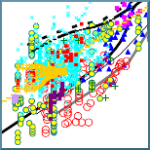EPJ B – New theory predicts dispersion in porous solids
- Details
- Published on 08 April 2011

Modeling the transport of fluids in porous solids is a problem of general interest for its implications in construction engineering, industrial catalysis, hydrology, agriculture and geology. The classical approach uses an equation derived from continuum mechanics which is problematic and often gives incorrect predictions. When the porous medium presents many scales of variability the problem becomes intractable.
EPJ B - Solids under pressure
- Details
- Published on 15 March 2011

Constant-pressure molecular dynamics simulations allow the study of systems where external pressure is a driving force for a structural transformation.
EPJ B - Geometry matters
- Details
- Published on 24 February 2011

A colloquium published in EPJ B provides a thorough formulation of the theory of the insulating state by means of geometrical concepts, which were somewhat hidden and implicit in the original literature.
EPJ B - Complexity Theory and the National Baseball Hall of Fame
- Details
- Published on 07 February 2011
Individual success in competitive endeavors, such as sports or academia, is the result of many factors, some of which are time-dependent. In order to compare human achievements from different time periods, we need to normalize success metrics so as to avoid a time-dependent bias in the comparison of the statistical measures. A novel 'detrending' approach presented in EPJ B removes precisely this bias and allows for an objective comparison across time.
EPJ B – Au and Cu as building blocks of high-density memory devices
- Details
- Published on 22 December 2010
Gold and copper atoms adsorbed on a NaCl surface behave as isolated atoms and complex electronic interactions with the surface are negligible. A study by a group of Brazilian researchers uses first-principles simulations to measure the electronic and magnetic properties of gold and copper atoms adsorbed on NaCl(001) surfaces, as well as the modifications in these properties upon charge injection.
EPJ B – A step up in the game of electron-ion dynamics simulations
- Details
- Published on 10 November 2010

A Colloquium paper by McEniry et al. published in EPJ B surveys the theory and applications of a new family of computational methods, namely Correlated Electron-Ion Dynamics, which enable the simultaneous evaluation of the electronic current, along with the current-induced forces and subsequent motion of the nuclei.
Discounted Open Access fee for Physical Society members
- Details
- Published on 18 October 2010
Members of the European Physical Societies represented in the EPJ Scientific Advisory Committee who choose to publish their EPJ paper in open access enjoy a 10% discount on the open access fee. For detailed information on how open access works in EPJ please click here.
EPJ B – Longitudinal polarization analysis, SANS souci
- Details
- Published on 01 October 2010

Ground breaking experiments in EPJ B by D. Honecker and colleagues on an FeCr two-phase nanocrystalline alloy demonstrate the power of one-dimensional neutron-spin analysis in a small-angle neutron scattering (SANS) experiment.
Geysers of Helium burst as if liquid
- Details
- Published on 14 September 2010

New experiments on the flow of solid He through a microscopic hole reveal a mechanism that triggers the geysers based on the breakdown of a plug located upstream of the source chamber.
The vacuum expansion of solid helium through a micrometric orifice was suggested as a mean to inject excess vacancies into the solid bulk [R. Grisenti et al, J. Electr. Spectr. 129 (2003) 201]. But while the He flow seems smooth, unexpected periodic bursts out of the orifice (geyser effect) are observed during these vacuum expansion experiments.
EPJ B - Superfluidity of a perfect quantum crystal
- Details
- Published on 11 June 2010
Only one liquid exhibits Bose-Einstein condensation in nature: Helium II, . At such temperatures, all other substances are solid. In these two papers, Vitaly Golovko demonstrates that Bose-Einstein condensation can also occur in the solid state. Moreover, it is shown that at 0 K, a condensate crystal is energetically preferable with respect to the same quantum crystal without condensate. Therefore, on lowering the temperature of the crystal there must somewhere happen Bose-Einstein condensation, as in liquid helium. This opens a huge field for experimental investigations of Bose-Einstein condensation and of its influence on properties of solids.
Click here to view the full papers:
[V. Golovko, Eur. Phys. J. B 71 1 (2009) 85-95] and
[V. Golovko, Eur. Phys. J. B 74 3 (2010) 345-356]




